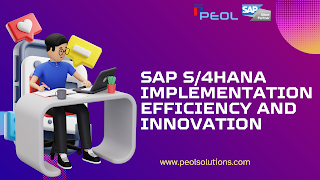A Guide to SAP S/4HANA Implementation Efficiency and Innovation
Introduction:
SAP S/4HANA is a groundbreaking enterprise resource planning (ERP) system that empowers organizations to optimize their operations, drive innovation, and embrace digital transformation. Its robust capabilities and intelligent features enable businesses to streamline processes, gain real-time insights, and remain competitive in today's fast-paced business landscape. In this blog post, we will explore the key aspects of SAP S/4HANA implementation and provide valuable insights for a successful deployment.
Understanding SAP S/4HANA:
Begin by gaining a comprehensive understanding of SAP S/4HANA and its advantages over previous SAP ERP systems. Explore the innovative features, such as the in-memory computing platform, advanced analytics, simplified data models, and user-friendly interfaces that enhance productivity and decision-making.
Pre-Implementation Planning:
A successful SAP S/4HANA implementation starts with meticulous planning. Evaluate your organization's existing systems, business processes, and data structures. Identify areas for improvement and define clear goals and objectives for the implementation. Engage stakeholders from different departments to ensure a holistic approach.
Data Migration and Cleansing:
Data migration is a critical aspect of any ERP implementation. Cleanse and validate your data to ensure accuracy and integrity before migrating it to SAP S/4HANA. Define migration strategies, establish data governance practices, and conduct thorough testing to minimize disruptions during the transition.
System Configuration and Customization:
Configure SAP S/4HANA to align with your organization's unique business requirements. Leverage the flexibility of the system to customize processes, workflows, and reporting structures. Strike a balance between standard functionality and tailored adaptations to optimize efficiency and user experience.
Integration and Interfaces:
Evaluate existing integration points and determine how SAP S/4HANA will interact with other systems, such as CRM, supply chain management, or third-party applications. Implement robust integration mechanisms, such as SAP Cloud Platform Integration, to ensure seamless data flow and end-to-end process visibility.
Change Management and User Adoption:
A successful implementation depends on effective change management and user adoption strategies. Communicate the benefits of SAP S/4HANA to employees and involve them in the process. Provide comprehensive training and support to ensure a smooth transition and foster user acceptance and engagement.
Testing and Quality Assurance:
Thorough testing is crucial to identify and resolve issues before going live with SAP S/4HANA. Develop comprehensive test scenarios and execute them to validate system functionality, performance, and security. Collaborate closely with the implementation partner or SAP experts to ensure quality assurance.
Go-Live and Post-Implementation Support:
Carefully plan and execute the go-live phase, considering factors such as timing, operational readiness, and contingency plans. Monitor the system closely after the go-live and provide post-implementation support to address any issues or user concerns. Continuously evaluate system performance and leverage SAP's support channels for ongoing assistance.
Conclusion:
SAP S/4HANA implementation can revolutionize your organization's operations, enabling efficiency, agility, and innovation. By understanding the key aspects of implementation and following best practices, you can ensure a successful deployment. Embrace the power of SAP S/4HANA and unlock new possibilities for your business in the digital era.




Comments
Post a Comment